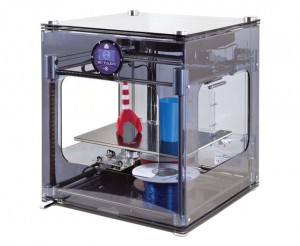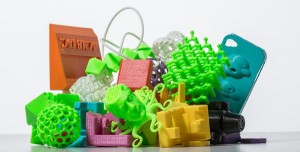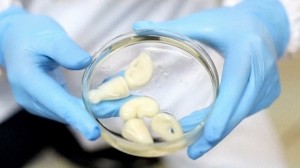3D Printing will Affect the Future of Humanity
What do you think of when you hear the word “printer”? Most common people think of the printer we use in our every day life, the 2D printer that prints out ink onto blank paper. We now need to start thinking about the 3D printer, technology that will change the near the future with all its possibilities. The Institution of Electronics and Telecommunications explains the 3D printer as a device that creates 3D objects from 3D computerized modeling programs. It builds objects by layering a material, usually rubber or plastic, on top of each other until the object is created (Kaur 360). This is important because it allows the freedom of design because objects can be made in a variety of shapes on the spot. This leaves me to wonder how 3D printing could affect human life in the future of humanity. There are endless possibilities for 3D printing. It will be used in the future to create human organs, guns, food products, manufactured goods, and maybe even some day whole buildings. It also has negative side effects because it could be used to manufacture illegal guns and there is an controversy around the ethics of creating artificial human organs. One thing is certain though, 3D printing will have a large impact on human life in the future.
Manufacturing Benefits of 3D Printing
3D printing will change the world, as we know it today. There are just too many possibilities and advantages that the 3D printer brings to not change the world. This first place where it could really affect globally, when the technology expands and the price drops, is the manufacturing world. It could revolutionize the material world in the near future because prices of these products would be closer to their actual price to produce them. Products would be cheaper because items that use to rely on large scale outsourced centralized plants could now be made locally because of the 3D printer.
The costs might be higher to produce the products but the elimination of large shipping costs and the ability to make items on demand will offset this increase of price. This would a huge improvement to the manufacturing world because of the rising fuel costs and the ability to bring back jobs to developed countries instead of outsourcing them. It could create jobs in the local plants and also for engineers to develop 3D models for the printers to create these products.
This would also benefit the consumers because the customization the 3D printer allows them to replace unique parts in a considerable less time. Repair shops will be able to replicate the item through 3D printing instead of having to order the part . In the future once the technology becomes more readily available, the prices of 3D printers will drop and will be a regular household necessity. 3D printing will allow the user to have the capability of printing in their own household, which would eliminate shipping costs. A household printer now costs $2,000 and it gives the user to ability to customize unique household items cheaply. The impact of 3D printing in the manufacturing realm might seem futuristic, but it is closer to reality than it might seem.
Medical Benefits of 3D Printing
Similarly, 3D printing could have the same amount of impact in the medical field. It could in the future be used to create human body parts and human organs. This would save lives of countless people around the world if this technology were successfully created. 3D printing has the potential to create and then replace organs that maybe are diseased or not functioning properly. The impact of this would be huge because there are currently 120,000 people waiting for organ transplant just in the United States alone (Schubert 160). It would instantly save lives because it could provide the organs the patients needed using their own DNA. This is significant because there is no chance for the patient’s body to reject the organ because it is their own DNA. The progress in creating human organs using 3D printing in recent years has been significant. For example, Harvard researchers have created tissue interlaced with blood vessels by using “disappearing” ink. The creation of blood vessels in organs has been a huge problem in the past. It is the small steps like this one that one day will save the lives of people around the globe through 3D printed organs.
Negative Consequences of 3D Printing
Ethics:
There are also ethical concerns behind 3D printing because it has the possibility to be used to create fully functioning human organs. The printers could be able to create customizable body parts and organs that could have a tremendous upside in the medical field. Doctors would be able to build and replace organs quickly and wouldn’t have to worry about donor rejection because they will be built using patient’s DNA. The advantages of this are astronomical but again there are ethical concerns with organ printing. The beginning stages of organ printing will have a large failure until the medical professionals can figure out the exact right methods and techniques that will lead to the huge benefits that organ printing offers. It would be a difficult for the doctors to explain the risk of organ printing in the first stages to the patients because doctors wouldn’t really know what to expect. The first human patients would be “guinea pigs” of the new technology of organ printing.
Also the cost of the procedure would be expensive so the patient would have to be able to afford the new technology. This leads into the issue that we have today whether or not to deny this new and improved medical treatment to patients because they can’t afford it. This is a serious ethical question, as medical technology is improving yearly but it comes at a high price for the medical patients. Is it ethical to deny treatment to a patient, who might not have enough time to wait for another type of treatment?
Guns:
With the 3D printer being such a revolutionary technology, there are also some drawbacks of the 3D printer because with all these possibilities, there is room for people to use it for the wrong reasons. The 3D printer allows gun parts to be manufactured in people’s own houses through 3D blueprints on the Internet. This conflicts with the gun control debate that is happening throughout the United States after the recent mass shootings. People will be given the freedom to manufacture guns in their own homes without any registration or permit because of 3D printing.
This is a scary topic for not just Americans but the whole world because it can be easily accessed by anybody through the World Wide Web. This means it could get in the hands of the wrong people and they could start manufacturing guns with the right technology. With the technology of 3D printing advancing at such a rapid pace, it is going to be sooner rather than later that someone uses a 3D printed weapon to kill or hurt someone.
Ways to Overcome Negative Side Effects
Personally, I believe that the advantages of 3D printing far outweigh the negative side effects it brings about. The twenty-first century has been all amount the technological improvements in the various aspects of human lives. There is no reason to stop this now; 3D printing is going to change the world for the better. The possibilities of its impact in the manufacturing and medical fields, as well as countless others will improve the way humans live their life. 3D printing might have the negative side effects of gun control and the debate whether artificial human organs are ethical, but I believe these side effects can be overcome with solutions as innovative as the 3D printer itself. One of the ethical concerns was if people in need of the organ transplant would be able to afford it. I believe at first, it would be a struggle to give every patient the procedure because of the expensive startup cost. This is the case with almost every brand new technology though, the price goes down once it becomes more widely available and more popular. I believe over time this will become a medical procedure that will be common for any person to receive, no matter how much they make.
The 3D printing of guns without any government control is a dangerous side effect because you don’t know whose hands they are getting into and what they are being used to do. This side effect will garner attention throughout the nation, as 3D printing becomes more and more prominent. I believe like the United States has had to do in the past, it will have to evolve to the ever changing technology and do what keeps its citizens most safe without denying the rights this country was founded on. This will be difficult because who knows where the 3D printing of guns will be in 5 years but it will have to be done. With the Internet almost nearly impossible to monitor, the government will have to dedicate more resources to see who is downloading the gun blueprints and buying certain gun parts and bullets online. Hod Lipson, a 3D printing expert at Cornell University, suggests that the control of gunpowder could also maybe be a partial solution to help eliminate 3D printed guns from getting used illegally.
Conclusion
3D printing will revolutionize the world in overwhelming positive manner by creating an overall better life for humans globally. In the near future, it will provide safe organs and body parts to the people that need them for a reasonable price. It will decrease shipping costs and hopefully help preserve some of the limited natural gas on earth. It will bring jobs back to developed countries and consumers would benefit from the high degree of customization the 3D printer allows. I am positive that 3D printing will affect human life in the future in a positive way and will be the next large step forward for mankind. I can’t wait to see the endless possibilities.
Works Cited:
Kaur, Satwant. “How Is “Internet of the 3D Printed Products” Going to Affect Our Lives?” IETE Technical Review 29.5 (2012): 360-64. EBSCO. Web. 15 Apr. 2014.
Schubert, Carl, Mark C. Van Langeveld, and Larry A. Donoso. “Innovations in 3D Printing: A 3D Overview from Optics to Organs.” British Medical Journal (2013): 159-61. EBSCO. Web. 15 Apr. 2014.




3D printing is, in some respects, no different than any other new technology – it comes with upsides and downsides. For example, smartphones are a boon to people worldwide; texting and talking on smartphones while driving a car is life-threatening. Similarly, while plastic and metal 3D printed guns have been made over the last year, people have been making, modifying and repairing guns at home for generations.
Awareness of the upsides and downsides of 3D printing are, as you point out, important if the technology is to continue to move forward and if the use of 3D printing is to become more widespread.